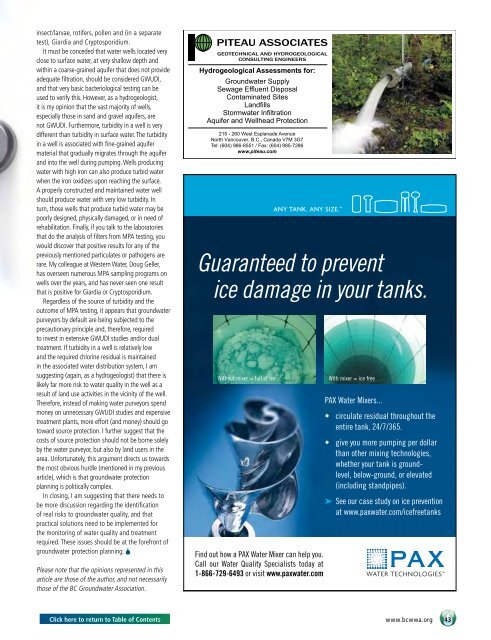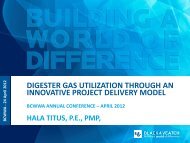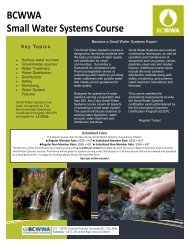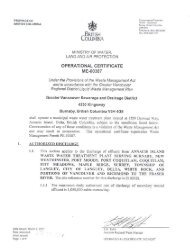Download - BC Water & Waste Association
Download - BC Water & Waste Association
Download - BC Water & Waste Association
Create successful ePaper yourself
Turn your PDF publications into a flip-book with our unique Google optimized e-Paper software.
insect/larvae, rotifers, pollen and (in a separate<br />
test), Giardia and Cryptosporidium.<br />
It must be conceded that water wells located very<br />
close to surface water, at very shallow depth and<br />
within a coarse-grained aquifer that does not provide<br />
adequate filtration, should be considered GWUDI,<br />
and that very basic bacteriological testing can be<br />
used to verify this. However, as a hydrogeologist,<br />
it is my opinion that the vast majority of wells,<br />
especially those in sand and gravel aquifers, are<br />
not GWUDI. Furthermore, turbidity in a well is very<br />
different than turbidity in surface water. The turbidity<br />
in a well is associated with fine-grained aquifer<br />
material that gradually migrates through the aquifer<br />
and into the well during pumping. Wells producing<br />
water with high iron can also produce turbid water<br />
when the iron oxidizes upon reaching the surface.<br />
A properly constructed and maintained water well<br />
should produce water with very low turbidity. In<br />
turn, those wells that produce turbid water may be<br />
poorly designed, physically damaged, or in need of<br />
rehabilitation. Finally, if you talk to the laboratories<br />
that do the analysis of filters from MPA testing, you<br />
would discover that positive results for any of the<br />
previously mentioned particulates or pathogens are<br />
rare. My colleague at Western <strong>Water</strong>, Doug Geller,<br />
has overseen numerous MPA sampling programs on<br />
wells over the years, and has never seen one result<br />
that is positive for Giardia or Cryptosporidium.<br />
Regardless of the source of turbidity and the<br />
outcome of MPA testing, it appears that groundwater<br />
purveyors by default are being subjected to the<br />
precautionary principle and, therefore, required<br />
to invest in extensive GWUDI studies and/or dual<br />
treatment. If turbidity in a well is relatively low<br />
and the required chlorine residual is maintained<br />
in the associated water distribution system, I am<br />
suggesting (again, as a hydrogeologist) that there is<br />
likely far more risk to water quality in the well as a<br />
result of land use activities in the vicinity of the well.<br />
Therefore, instead of making water purveyors spend<br />
money on unnecessary GWUDI studies and expensive<br />
treatment plants, more effort (and money) should go<br />
toward source protection. I further suggest that the<br />
costs of source protection should not be borne solely<br />
by the water purveyor, but also by land users in the<br />
area. Unfortunately, this argument directs us towards<br />
the most obvious hurdle (mentioned in my previous<br />
article), which is that groundwater protection<br />
planning is politically complex.<br />
In closing, I am suggesting that there needs to<br />
be more discussion regarding the identification<br />
of real risks to groundwater quality, and that<br />
practical solutions need to be implemented for<br />
the monitoring of water quality and treatment<br />
required. These issues should be at the forefront of<br />
groundwater protection planning.<br />
Please note that the opinions represented in this<br />
article are those of the author, and not necessarily<br />
those of the <strong>BC</strong> Groundwater <strong>Association</strong>.<br />
click here to return to table of contents<br />
p-494.pdf 1 12-01-27 8:18 AM<br />
www.bcwwa.org 43









